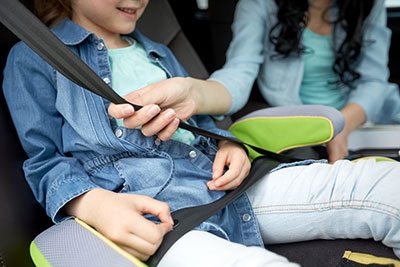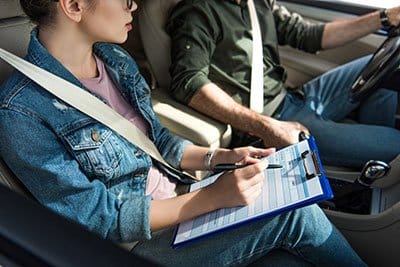Keeping your children's safety on the road is a top priority for all parents. Ensuring there won't be any harm or even the slightest possibility of injuries gives you peace of mind. But what do you do once your child overweights the booster seat?
It's time for the vehicle seat belt. And how do you know if a seat belt works well? First, you must perform the 5 step seat belt test to ensure your child's safety.
More...
Take Away Key Points:
5 step test to ride without a booster seat: All you need to know
If you want to know more about when your child is ready to use the vehicle seat belt, how to use it properly, and how to perform the 5-step safety test, read the guidelines below. We will answer all your questions.
What is a 5 step test for the safety of children?
The 5 step test is a safety test used to determine whether your child sits in the car seat restrained with the car seat belt properly. The five-step test includes five crucial factors to decide whether the child can use adult seat belt straps.
What are the steps in the 5-step test for the adult seat belt?
The five-step test uses the following precautionary measures:
1. The shoulder belt crosses between the shoulder and neck

When the shoulder belt is too close to the neck, children might be tempted to put it behind their backs for more comfort. You must make the belt sit across the middle of your child's shoulder. A shoulder belt sitting off the child's shoulder can slip off in the case of an accident and cannot protect your child correctly.
2. Lower back is always against the vehicle seat
When your children sit with their bottom forward, allowing their legs to go over the edge of the seat to be more comfortable, there will be a gap between the car seat and their backs.
In addition, the vehicle seat belt will cover their stomach instead of their upper thighs. The vehicle seat belt might also introduce slack, allowing the children to move forward in the case of an accident. However, your child might suffer serious injury in the collision.
3. Lap belt rests on the upper thighs across the hip bones
When the lap belt crosses the soft tissue of the abdomen, the lap belt will damage the internal organs in the car crash. The forces are similar to seat belt syndrome.
The seat belt syndrome is a pattern of severe injuries to the spinal cord and abdominal organs leading to paralysis, spleen removal, and colostomy bags.
However, the children will be safe when the lap strap sits across the child's hips and touches their upper thighs. But, when your child's back is not against the car seat correctly, they can suffer from various injuries.
4. The child's knees bend at the edge of the seat
Children might scoot their bottom forward and let their knees bend comfortably. However, children will cause injuries as the lap belt sitting low will now rise up and off their hips and cover their stomachs. So, if the child's knees bend over the edge of the seat when they are tall enough, they won't suffer a spinal cord, inner organs, and similar serious injury.
5. Your child can ride like this for the entire ride
No one expects your child to sit still during the whole ride. Their movement will cause the adult seat belt to move its position, and the straps might not fit properly. So, the best practice is to teach them how to use their adult seat belt properly and find the best position for their child's body.
What happens if children can not pass the 5 step test?
If your child cannot comply with these five steps above, they are not ready for the booster car seats, let alone adult seat belts. Only when:
- The child's body is correctly positioned in the vehicle seat,
- The shoulder strap covers the child's shoulder and
- The lap portion fits the upper thighs and hips,
- The child passes the test and uses a booster or adult seat belt for the entire trip. If not, you must make your child stay seated correctly in the right car seat.
How to choose a seat?
To choose the right car seat for your child, you must refer to the most important factor - weight and height limits. This is the most important factor, as it allows your child to use the car seat for an extended period.
Most children are problematic when transitioning from a forward-facing harness to the booster seat. On the other hand, parents might rush and place their children in the booster seat or even the seat belt system when they are not ready.
The 5-step booster test only indicates whether your child can use the belt system for the entire trip. If not, they will have to return to the harness straps.
When are kids ready for the car seat 5-step test?

Older children can use the vehicle seat belt when they are four feet nine inches tall, between eight and twelve. But, experts state you should keep your child in the booster seat as long as possible until the child's feet can touch the floor and their knees bend over the edge of the seat.
Once older children outgrow their booster seat, they can use seat belts, and when they are thirteen years old, they can sit in the front seat. First, of course, you can perform the five-step test to make your child stay seated correctly in the front or back of your vehicle, as this is the only indicator to show mistakes.
Summary
So, can your child pass the 5 step seat belt test? You will know if you answer these five questions:
1. Can a child sit with their back against the seat?
2. Do your child's knees bend over the edge of the set?
3. Is the lap belt sitting low and covering the child's hips and upper thighs?
4. Does the sash belt sit across the child's shoulder?
5. Can your child sit in this position during the ride?
If you answer yes, your child is ready for a booster or seat belt. If not, you must transition your child to the harnessed seat.
